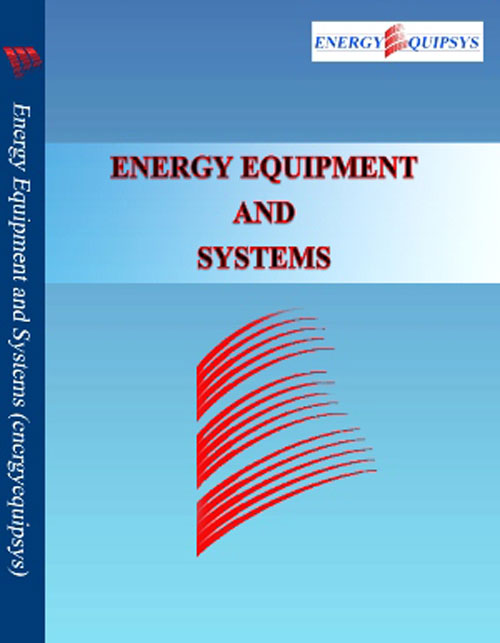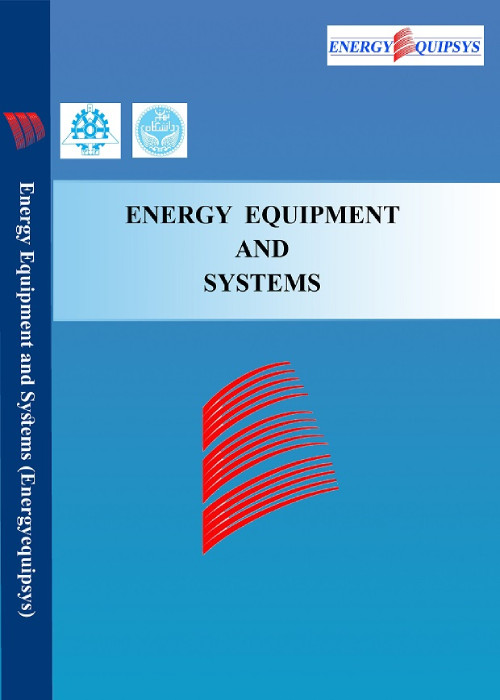فهرست مطالب

Energy Equipment and Systems
Volume:2 Issue: 2, Summer and Autumn 2014
- تاریخ انتشار: 1393/08/20
- تعداد عناوین: 7
-
-
Pages 103-119In this study, the effect of the levels of hydrogen addition to methane-air premixed flame in a micro-stepped reactor has been studied numerically. In addition, the effects of mixture velocity and walls thermal conductivity (Kw) on the flames location, temperature, and species distribution in a micro reactor were calculated using a 2D numerical laminar steady code. The results showed that an increasing level of hydrogen in the methane-air mixture probably improves the combustion process in a micro reactor by intensifying the flame speed, adiabatic flame temperature and the generation of some crucial species (such as OH, H, HCO, HO2, and H2O2). Further, it was found that the addition of hydrogen to methane can shift the flame towards the inlet. In this way, it probably guarantees the flames presence in certain conditions compared to cases of no hydrogen addition. In conclusion, it is shown that the temperature distribution along the axis and the wall of the micro reactor can be dependent on the amounts of hydrogen added to the methane-air mixture.Keywords: Micro tube, Step, methane, Air, Hydrogen, Reduced chemistry
-
Pages 121-128Wind turbines are important devices that extract clean energy from wind flow. The efficiency of wind turbines should be examined under various working conditions in order to estimate off-design performance. Numerous aerodynamic and structural research works have been carried out to compute aeroelastic effects on wind turbines. Most of them suffer from either the simplicity of the modelling approach or from the difficulty of the computing technique, which limits the practical applicability of the results. In this research, a robust approach is proposed to compute the aeroelastic behaviour of a horizontal axis wind turbine blade profile for conceptual design purposes. The simplicity and applicability of the approach are the significant points of the research work. Aerodynamic and elastic computations made using XFOIL and MATLAB PDE toolbox. Those tools are linked through an algorithm to interactively compute aeroelastic effects. A real measured time history of wind velocity is used as an input flow condition to simulate a real angle of attack for aeroelastic computation. Investigation of numerical output shows lift and drag coefficient values are lower compared to the corresponding values of the rigid profile. The study of modulus of elasticity value on the separation point location is also conducted, and the delayed stall is observed by decreasing the airfoil rigidity.Keywords: Aeroelasticity, Wind Turbine, Fluid Structure Interaction
-
Pages 129-140In this paper, a multi-objective method is used to optimize a heat recovery steam generator (HRSG). Two objective functions have been used in the optimization, which are irreversibility and HRSG equivalent volume. The former expresses the exergetic efficiency and the latter demonstrates the cost of the HRSG. Decision variables are geometric and operational parameters of the HRSG. The results of the multi-objective optimization are shown in a famous curve called the Pareto curve. The resulting Pareto curve can be used as a decision making tool by designers. Different optimal parameters are presented for different weight coefficients in the function. Volume and exergy optimization are special cases of the proposed algorithm. It is also shown that thermoeconomic and multi-objective optimizations can also be specific cases of the proposed algorithm if the proper weight coefficient is used. This weight coefficient depends on local prices of energy and construction costs of the HRSG.Keywords: Combined Cycle, HRSG, multi, objective optimization, Thermoeconomic
-
Pages 141-154Passive solar systems such as solar chimneys need solar radiation in order to work. Therefore, they cannot present stable natural ventilation when solar energy vanishes: to have a more robust and stable condition, solar energy should be stored during the day and released back during the night. Phase change materials can save additional thermal energy during the day and release it during the night in order to facilitate stable ventilation. In this study, a CFD simulation has been performed to investigate the effect of phase-change materials (PCM) utilization in the solar chimney to provide a stable temperature and air flow rate for a guardroom. The simulation was carried out for a whole day in winter in two cases: with and without PCM usage. The results show that use of PCM as an energy storage device significantly enhances the temperature stability of the guardroom.Keywords: Passive Heating, Solar Chimney, Phase Change Materials (PCM), CFD Simulation, Parallel Computing
-
Pages 155-170Nowadays, energy plays an important role in the economic and community development of country. Consequently, performance analysis of energy systems is one of the effective methods being used to prevent waste of energy resources. Among the different power generation technologies, steam power plants make a significant contribution to power generation in Iran, with a share of 47 % of electricity generation. Therefore, it seems that exergy analysis of the power plant can help designers to reduce energy losses and increase efficiency. In this study, energy and exergy analysis of a single-reheat steam power plant in Iran is presented. This analysis considered the effect of environment temperature variation on the energy and exergy efficiencies. The results showed that the condenser has most energy losses (50%) in a cycle, while maximum exergy destruction (84%) occurs in the boiler. The thermal and exergy efficiencies at reference temperature were computed as 36.84% and 34.75%, respectively. Exergy destruction and efficiency of each component have been considered and are reported in the paper. The effects of various parameters such as steam pressure, steam temperature and condenser pressure have also been examined in the cycle performance.Keywords: Boiler, Energy analysis, Exergy analysis, Steam power plant, Thermal efficiency
-
Pages 171-184Industrial energy consumption lies between 30% and 70% of the total energy consumed in selected countries. Cement production is one of the most energy intensive industries all around the world. This paper deals with an energy audit analysis in a cement plant in Iran. In all recent works, after performing an energy audit, different strategies are offered to reduce energy losses. Generally, these strategies differ from the viewpoint of economics and their extent of loss reduction, which makes it difficult to choose one of them. In this paper, a decision-making procedure such as an analytic hierarchy process (AHP) after an energy audit process is proposed to help the decision maker in this process.Keywords: cement industry, Energy Audit, Heat, Electricity Balance, Decision, Making Procedure
-
Pages 185-193Wind power has been widely considered and utilized in recent years as one of the most promising renewable energy sources. In the current research study, aerodynamic analysis of the upwind three-bladed horizontal axis turbine is carried out using blade element momentum theory (BEM), and a genetic algorithm (GA) is applied as an optimization method. Output power generation is considered as an objective function, which is one of the most common choices of objective function. The optimization variables also involve chord and twist distribution variations and the placement of the airfoil sections along the blade length. The optimal blade shape is investigated for the maximum output power at a specific wind speed, rotor diameter and airfoil profile. The modified BEM results are compared with an experimental measurement indicating reliable results. The results show that considering placement of the airfoils as design variables in addition to chord and twist rate has a significant effect on the optimal output power. Finally, the objective function (output power) is improved by 10% compared to the base function.Keywords: Aerodynamic, BEM, GA, Optimization, Output Power, Wind turbine blade


